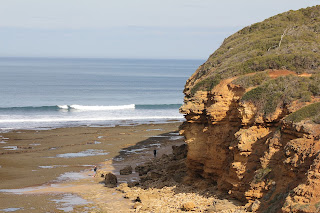The Great Ocean Road
We began our Great Ocean Road adventure the day after surfing.Well, after stopping off back at Bells to see another famous surf spot called Winkipop, and taking a selfie at Bells...
Bells selfie
Winkipop - an arguably better reef break than Bells.
We drove down the road to Angelsea and had a wander around there, and at the spit found some funky rocks. Here's Charlotte posing in front of some funky rocks:
After Angelsea, we hit the Great Ocean Road proper! It's marked by this famous sign and statue, along the road past Angelsea. We stopped for some pictures:
The Great Ocean Road is a 151 mile stretch of road along the south coast of Victoria, mostly hugging the cliffline along the sea. It was built as a memorial to fallen WW1 soldiers by their comrades when they returned home between 1919 and 1932, which also provided them with employment with the people they'd spent the last few years fighting with. It is a stunning coastline, running over vast cliffs through deep gorges and along beautiful beaches. Whales can be seen migrating off the coast and there is a vast swathe of forest lining the inland areas. We stopped off at one of these forests to venture down to Erskine Falls, which was quite a hike down steep cliffs to get to!
After Erskine Falls, we drove further along down the coast and came to Teddy's Lookout. This was a brand new lookout above a cute little beach , rivermouth and valley:
Further on down the GOR (Great Ocean Road), we came across the town of Lorne, which we had a stop off at to refuel both the van and ourselves. Charlotte also summoned a flock of some of her favourite birds, the cockatoos, which assembled next to the van. These are extremely intelligent and curious birds.
We carried on after Lorne to a spot we had been to before and our campsite for the night, Kennett River. Kennett River is home to some great wildlife, and we had Koalas in the trees above our van in the morning (didn't take photos as we'd just woken up and were getting ready to leave). We also went up to the forest above and saw some glowworms when the sun went down. We couldn't get a picture of them due to our puny phone cameras, but they looked like this:
In the morning, we checked out and headed over the footpath to one of the memorial spots we went to last time we were here. Kennett River is home to a load of parrots and lorikeets, and they really like to be fed. These are all wild birds:
This time, unlike 3 years ago, I didn't get pooped on.
The next stage of our GOR adventure was the famous '12 apostles', of which there are now 8 due to erosion. They are essentially sections of the old cliffs which have remained standing while the cliffs have been weathered back behind them, and they are currently still being eroded down at an astonishingly fast rate. They are sandstone, and as such, are really prone to weathering.
Charlotte tried to eat one
The photo above shows 'Gibsons Steps', a big wave surf spot and home to a couple more rock stacks. There was one lone surfer out, and Charlotte told me I wasn't allowed to join him.
So instead, we carried on down the road to another famous spot, Loch Ard Gorge, so named thanks to the passenger ship that was sunk just off the gorge on shallow reef in 1878, from which there were only 2 survivors, who found themselves washed into the gorge. This is home to a few interesting geological features. The first one we went to was the 'Thunder Cave' (awesome name for a rock band, might I add), a cave in which the water pressure builds up along a cut in the cliff and explodes out with a loud roar, which echoes into the cave, sounding loudly like thunder. You can hear it well before you see it.
THUNDER CAVE
After that, we walked along to Loch Ard Gorge. This is another spot we visited last time, and this is the site of the sunken ship. It's extremely calm in the gorge, but outside the sea is much rougher. It's flanked by very steep, fragile sandstone cliffs.
Loch Ard Gorge
As the sun began to set, we ventured around the gorge area and found more rock stacks:
And this, an elongated stack called the Stickleback:























































